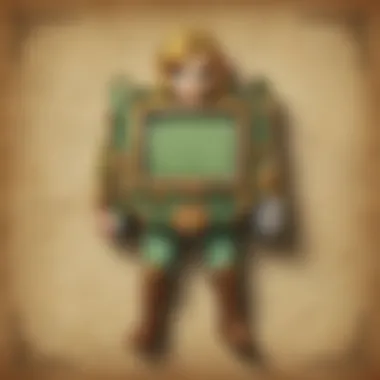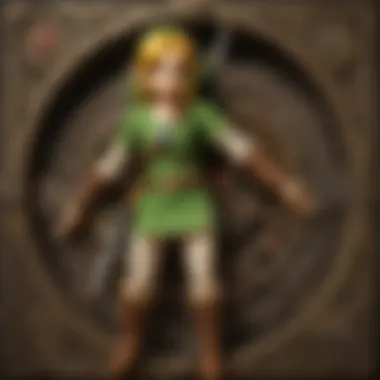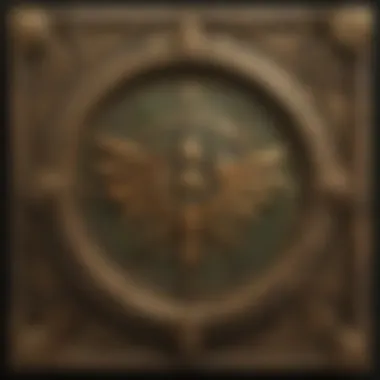Exploring the Legacy of Zelda Game and Watch


Intro
The world of video games has seen its fair share of innovation and nostalgia, but few items encapsulate both in a single package like the Zelda Game and Watch. Originally released in the 1980s, this compact device was more than just a handheld gaming console; it was akin to a portable gateway to Hyrule. For fans of the franchise, it's a tangible piece of history that beckons memories of simpler times and pixelated adventures. Understanding the Zelda Game and Watch isn't just about games; it’s about cultural significance, nostalgia, and the artistry behind its design.
Every button press and mini-screen flicker holds stories that connect generations. In this exploration, we'll map out the various facets that make the Zelda Game and Watch such an iconic item.
Game Reviews
Gameplay Features and Mechanics
At first glance, the gameplay of the Zelda Game and Watch appears deceptively simple. Featuring a very limited set of mechanics, players control Link in a quest that revolves around collecting the pieces of a Triforce-like object. The primary action consists of moving Link left or right, while also jumping to avoid obstacles and enemies.
Yet, underneath this basic framework lies a layer of challenge. As players progress, the speed increases, making it a test of reflexes and hand-eye coordination. The minimalistic design adds to its charm; it’s like playing a vintage arcade classic.
Storyline and Quests
While some might argue that the Zelda series often thrives on rich narratives, the Game and Watch version takes a different route. Its storyline is not as expansive or elaborate, focusing instead on the core task: find the lost pieces and restore balance. However, this simplicity allows for quick plays, making it perfect for short gaming sessions while waiting in line or during a coffee break.
Visuals and Sound Design
The visuals are undeniably retro, with a few static screens mimicking Hyrule's essence in a pixelated format. This aesthetic doesn't detract from its appeal; rather, it adds to the nostalgia. The sound design, featuring simple beeps and melodies, might seem rudimentary compared to modern games, yet it struck chords of appreciation for many players who grew up with these sounds.
Comparison with Previous Titles
When placed next to other Zelda titles, the Game and Watch stands as a quaint reminder of gaming’s evolution. Where original console games offered sprawling maps and intricate storytelling, the Game and Watch’s charm lies in its concise experience. For many, it acts as a nostalgic bookmark, representing a period when games were straightforward yet engaging.
Character Analyses
Popular Characters Overview
Link remains the central figure, representing bravery and determination. Unlike his more detailed portrayals in later games, here he stands as a symbol of adventure with fewer lines and more action.
Character Development and Backstories
In the context of the Game and Watch, character backgrounds are quite simplified. There’s little room for deep backstories. Instead, players immerse themselves in Link’s timeless quest, relying on knowledge from established lore in other titles to fill in the gaps.
Role in the Zelda Universe
The Game and Watch serves as a piece of the broader Zelda tapestry. It enhances the franchise's mythos, embodying the core themes of courage and the eternal struggle against darkness, despite its limited format.
Fan Theories and Speculations
Fans have often speculated about how the Game and Watch fits into the larger timeline of the Zelda universe. Some posit its events precede major titles, while others argue it's a standalone experience. These theories only add to its allure.
Lore Discussions
Mythology and Worldbuilding
The mythology surrounding Link and Zelda adds depth to every linked game. In the Game and Watch setting, this foundation is present, albeit in its most elementary form. The mythos of light versus darkness is echoed through simple quests and challenges.
Legendary Items and Artifacts
Though streamlined, the focus on the Triforce motif alludes to the significant artifacts of the legend. This gives a nod to the rich lore that players have come to expect from the franchise.
Link to Real-world Mythologies
There's a fascinating crossover with various mythologies that players and fans have drawn parallels to. The notion of a hero's journey, the battle against evil, and the restoration of peace resonate through countless cultures, thus enriching the narrative.
Timeline Placement and Theories
Unpacking where exactly the Game and Watch fits into the timeline is a tricky task. Perhaps it exists in a realm of its own, allowing players to enjoy a slice of adventures without deep narrative entanglements.
Gameplay Strategies
Combat Techniques and Tips


For those seeking to excel, mastering the rhythm of movement is key. Timing jumps correctly can save Link from inevitable traps and foes.
Puzzle Solutions and Walkthroughs
Despite its limited gameplay mechanics, some encounters require strategy. Familiarizing oneself with the patterns of enemy movements can guide players to victory.
Collectibles and Side Quest Guides
Due to the nature of the Game and Watch, collectibles primarily focus around gathering pieces. However, having a sharp eye for detail can reveal shortcuts or speed boosts.
Boss Battles Tactics and Strategies
Though boss battles occur on a small scale, handling them requires precise coordination. Reacting quickly to attack patterns is your best strategy for overcoming challenges.
Historical Context of Zelda Game and Watch
Understanding the historical context of Zelda Game and Watch is essential for grasping its significance within both gaming history and the broader cultural narrative of the Zelda franchise. This device represents not just a novelty from the past, but a vital cornerstone in the evolution of portable gaming. As a handheld console, Zelda Game and Watch bridged the gap between classic arcade experiences and home consoles, providing a glimpse into the future of gaming on the go.
The Birth of Game and Watch
The Game and Watch series, created by Nintendo, was first released in 1980. This was a time when the gaming industry was budding, rife with innovation and experimentation. Gunpei Yokoi, an influential figure at Nintendo, conceptualized the idea of combining a simple game with a watch, emphasizing portability. Notably, the first model, called Ball, didn’t feature the characters we know today but set the stage for handheld entertainment.
This series featured an LCD screen and introduced players to a new style of gaming - one that could easily fit into their pocket. Each handheld console in the series typically included one game, and the player would interact with a basic mechanical design. Over the years, the series expanded to include more popular game concepts, leading us to Zelda’s unique introduction into this iconic lineup.
Zelda's Prologue in the Series
In 1989, Nintendo launched Zelda Game and Watch, a handheld device featuring an adaptation of the beloved franchise that started with The Legend of Zelda on the NES. This marked a pivotal moment, as Zelda brought rich narratives and characters to a platform that was suitable for quick, on-the-go play. The gameplay involved navigating Link through various challenges while maintaining the simplicity that Game and Watch fans had grown to expect.
What made this edition stand out was its innovative gameplay that honored the franchise's traditional mechanics while introducing a time-based element that was unique to the handheld format.
Cultural Impact on Gaming
Beyond its straightforward mechanics, Zelda Game and Watch seeped into the cultural fabric of gaming. Back then, video games were often seen as mere entertainments for hobbyists, yet this device lent a sense of respectability to portable gaming. Previously viewed as a niche, it opened the door for gaming as a widely acceptable leisure activity.
The nostalgia factor for many gamers today can be traced back to these early experiences. A few key elements illustrate its cultural impact:
- Accessibility: The simplicity allowed people unfamiliar with complex gaming systems to engage seamlessly.
- Collectibility: As the years rolled on, these devices became coveted collectibles. Fans sought them out in flea markets and online stores, hunting down every model.
- Crossover Appeal: By being part of the Zelda universe, it drew in not only die-hard gamers but also those who had yet to experience Zelda’s enchanting world.
"In the realm of gaming nostalgia, Zelda Game and Watch stands as a beacon for those who cherish both simpler times and the intricate stories of a unique franchise."
As we delve deeper into the gameplay and design mechanics of Zelda Game and Watch, understanding its roots helps clarify why this game holds a special place in the hearts of gamers even decades later.
Game and Watch Mechanics
In the world of handheld gaming, the mechanics underpinning devices like the Zelda Game and Watch are critical to understanding how these little gadgets captured the hearts of so many. The essence of these games lies not just in the characters or the story but predominantly in their gameplay features, their simplicity, and how they communicate through design. Apprehending these mechanics sheds light on the intimate relationship between players and the handheld experience.
Gameplay Features
When we dissect the gameplay features of Zelda Game and Watch, a few key elements come to mind—namely, their unique blend of challenge and charm. Unlike modern gaming, where graphics and expansive worlds reign supreme, yesterday's devices often focused on simplicity. In Zelda, players navigate Link through a pixelated landscape, encountering foes and solving puzzles, all achieved with minimal but effective controls. Here are some of the defining gameplay features:
- Limited yet Engaging Mechanics: The games featured limited buttons, but this restriction urged players to find creative solutions in gameplay.
- Score-Based Play: Accumulating points was the main objective, instigating a heightened sense of competition, whether battling against oneself or others.
- Evolving Levels: As players progress, the game ramps up its difficulty, pushing them to adapt continuously. This vital aspect instills a sense of accomplishment.
These features empower the mechanics to engage players deeply, allowing them to find joy in simplicity.
Control Simplicity and Accessibility
The control scheme is where the Zelda Game and Watch truly shines. One glance at the device reveals a straightforward layout designed for ease of use. The simplified controls are not just a product of its era but a deliberate choice to encourage accessibility among players of all ages. The idea is clear: gaming should be enjoyable, not a chore. Key points about control simplicity include:
- Intuitive Functions: Every button has a clear purpose, meaning even newcomers can pick up the game without fumbling through manuals.
- Portable and User-Friendly: Light and compact, the design allows for gaming on the go, making it easier to pull out during that quiet moment while waiting.
- Fostered Social Play: The easy controls also invite social interaction, allowing friends and family to join in, fostering co-op experiences even without modern online gaming.
This all goes back to a fundamental truth in gaming; accessibility often breeds enjoyment.
Visual and Audio Design Elements
Lastly, one must consider the visual and audio design that complements the mechanical aspects of the game. The Zelda Game and Watch’s graphics and audio are emblematic of the time but remain vivid in the minds of enthusiasts today. While rudimentary by today's standards, both elements contributed significantly to the overall experience.


- Pixel Art Aesthetics: The 8-bit visuals may seem outdated, but they hold an intrinsic beauty that evokes nostalgia among veterans. Characters are iconic, even in their simplest forms.
- Audio Cues: The beeps and boops carry layered meaning—every sound is designed to signal in-game events, serving as a guide for players.
- Mood and Immersion: The combination of visuals and sounds envelops the player, transporting them into the whimsical world of Hyrule, despite the limitations inherent in the technology.
"The beauty of Zelda Game and Watch is how it transcends the constraints of its medium, allowing players to engage their imaginations in shaping Hyrule’s landscapes."
Through these lenses—gameplay features, controls, and design—one gets a panoramic view of what makes the Zelda Game and Watch a fascinating piece of gaming history. The mechanics do not just serve the game; they shape the way players engage with their beloved franchise.
Design Aesthetics and Evolution
When discussing the Zelda Game and Watch, the focus on design aesthetics and evolution plays a pivotal role in understanding its impact and charm. This device represents a unique slice in gaming history, showcasing how art shapes user experience and nostalgia. The aesthetics of a game often transcend the visual; it encompasses character representation, graphical style, and how these elements contribute to the overall gameplay experience. The blend of function and artistry in Game and Watch is a testament to Nintendo's ingenuity, offering lasting impressions that resonate with gamers even decades later.
Iconic Graphics and Character Representation
The graphics of the Zelda Game and Watch defined its identity. The simplicity of its visuals—mostly two-dimensional sprites—was a hallmark of the era. Characters like Link are represented in minimalistic yet recognizable forms, instantly transporting players into the Hyrule universe. Each pixel holds significance, establishing an immediate connection with players, as character designs are not just images but symbols of a broader narrative. This simplicity encourages a deeper association with the gameplay mechanics
- Character Design: Link’s green tunic and pointed cap are iconic figures, fondly remembered by fans. The choice of colors and shapes meticulously captures his adventurous spirit.
- Environmental Backdrops: Also worth noting are the simplistic backgrounds, which reflect the atmosphere of Zelda, enhancing the playing experience. They are not merely decorations but vital parts of storytelling.
From Pixels to Nostalgia
The evolution of design aesthetics has led to a nostalgia that goes beyond mere gameplay. For many, seeing those pixelated characters evokes a rush of memories from childhood. Recall the first time you saved Princess Zelda? That moment is painted not only in memory but also in imperfect pixel art.
Over time, as technological advancements ushered in 3D models and photorealistic graphics, developers created more elaborate worlds, but the roots remain in those vivid pixels. They encompass a time when imagination filled in the gaps where graphics left off. You could say that pixels are like snapshots in a photo album—each one tells a story, creating an emotional attachment that many feel even years later. That blends ancient and modern, displaying how fundamental those designs are to the evolution of both visual storytelling and gameplay.
Comparison with Contemporary Designs
Contrasting the designs of the Zelda Game and Watch with modern gaming devices highlights significant changes in aesthetics and player engagement. Current gaming platforms tend to favor high-definition graphics and complex narratives, focusing on realism and immersive environments. Here’s a closer look:
- Simplicity vs. Complexity: The straightforward design of Game and Watch fosters an immediacy in gameplay that is often lost in the complex narratives of contemporary titles.
- Design Philosophy: Nowadays, aesthetics cater to realism, with intricate details in character models and environments meant for deep immersion. Doesn’t that seem to overshadow the charm of earlier designs?
- Cultural Reflection: The evolution of art in games mirrors cultural shifts as well. The retro look of Game and Watch resonates with a different era, one of simplicity and creativity. Today’s designs reflect technological advancements but may lack the warmth and familiarity of their 8-bit predecessors.
Narrative Elements within the Game and Watch
The narrative elements in the Zelda Game and Watch are essential for understanding the depth that the game brings to its seemingly simple mechanics. These elements give a rich layer of storytelling that enhances player engagement and contributes to the overall legacy of the franchise. The blend of character development, lore integration, and player choice creates a narrative experience that transcends the limitations of the hardware.
Character Arcs and Development
Character development in the Zelda Game and Watch may seem modest at first glance. However, Link, the protagonist, exhibits a form of evolution that resonates with players. In barely a few pixelated frames, players witness his journey from a mere boy to a hero wielding powers against threats.
The transitions in Link's character—and even Princess Zelda—offer players a personal attachment to the hero’s challenges. For instance, as players maneuver through dungeons, they observe Link picking up tools that not only help in the gameplay but also signify his growth. This gradual enhancement of capabilities mirrors classic hero’s journeys found in extensive literature and gaming, subtly encouraging players to invest emotionally in their digital avatar. While the narrative doesn't delve deeply into personal struggles, it’s easy to feel triumph at each level completed, echoing a sense of shared victory amidst the game’s simplicity.
Lore and Mythology Integration
Lore is another pillar that elevates the Zelda Game and Watch from a typical handheld device to a vessel of rich tales. The incorporation of elements from the larger Zelda mythos, such as the legend of the Triforce and different kingdoms, even within a limited context, creates an immersive experience.
Players are not just battling monsters; they're engaging in a world laden with history and mythical significance. For example, players encounter familiar enemies from the series, each representing a part of the lore. Learning how these villains fit within the Zelda universe enriches the overall experience, drawing players deeper into the story, even when the game is designed for quick play sessions. It serves as a bridge—linking past, present, and future stories.
Player Agency and Decision-Making
Despite its relatively straightforward design, players make choices, emphasizing their agency within the game. Each decision impacts how they navigate the challenges presented. Where to go first? Which items to prioritize? These questions echo throughout the gameplay, creating a dynamic of decision-making that feels significant, even in small-scale adventures.
This sense of agency is integral. While the game restricts complex dialogue or narrative twists, each choice creates an illusion of vast possibilities. Players become less of mere participants and more like authors of their paths, each session morphing into a unique journey through common yet beloved landscapes.
The power of Zelda Game and Watch lies in its ability to infuse character growth, rich lore, and player-driven narratives into an experience that feels expansive within its modest confines.
In sum, the narrative elements of the Zelda Game and Watch capture a snapshot of a deeper story. They illustrate how impactful games can be, even within the constraints of technology. This dynamic manifests through character arcs, enriched lore, and the players’ significant choices—all contributing to a compelling experience that resonates with fans even today.
Collectibility and Cultural Significance
In the realm of gaming collectibles, few items command attention quite like the Zelda Game and Watch. This handheld device transcends mere playability; it serves as a bridge connecting generations of players to a storied past. As the years have rolled on, this piece of nostalgia has morphed into something resembling a relic, charm, or even a trophy for fans of the Zelda franchise.
Market Trends and Value Fluctuations
The markers of what determines the value of a collectible can be as fluid as water. For the Zelda Game and Watch specifically, value fluctuates based on several factors: condition, rarity, and demand. Items still in their original packaging fetch a higher price, often skyrocketing during collector events or auctions. Recent years have shown a growing interest in retro games, breathing new life into these once-forgotten gadgets.
- Rarity: A limited-edition Zelda Game and Watch might yield bids that resemble those of fine art. For example, collectors willing to shell out upwards of several thousand dollars for high-value pieces reveal a passionate market that thrives on supply and demand.
- Condition: As with any collector's item, the better the condition, the higher the value. Units with visible wear and tear diminish in worth.
- Cultural Resurgence: The rise of gaming nostalgia has spiked interest, with online forums buzzing.
The question remains: will the market continue to favor these nostalgic treasures, or is it merely a passing phase? As demand shifts across different age groups, trends demonstrate that the Zelda Game and Watch is more than just a deep dive into nostalgia; it seems poised to remain relevant in the collector's circle for the foreseeable future.


Community Engagement and Events
The significance of collectible gaming can also be seen in the way communities rally around them. Zelda Game and Watch enthusiasts often congregate in various forums and social media platforms to share insights and tips. Events such as retro game fairs or comic conventions frequently spotlight these devices. Enthusiasts can explore tables cluttered with games, while avid collectors engage in friendly banter about acquisitions and valuations.
Participating in community events provides several benefits:
- Networking: Finding fellow collectors can turn isolated hobbyists into part of vibrant communities.
- Knowledge Sharing: Trade tips or even swap items - the exchange of advice can be invaluable.
- Exclusivity: Some events unveil limited-edition items or offer exclusive merchandise that draw collectors in.
Through these gatherings, the Zelda Game and Watch transcends its role as just a game. It morphs into an emblem of shared experiences between fanatics who hold dearly onto their beloved memories.
The Role of Social Media in Fandom
Social media has played a pivotal role in revitalizing interest in collectible gaming. Platforms like Reddit and Facebook facilitate the formation of communities where members can discuss game statuses, trade items, and commemorate their nostalgia.
- Discussion Boards: Subreddits dedicated to Nintendo or retro gaming provide a platform for valuable discussions, showcasing players’ collections and trading advice.
- Visual Platforms: Instagram and TikTok have transformed into visual archives where fans showcase their collections, generating excitement and eliciting envy among other enthusiasts.
Much akin to a modern-day town square, these platforms breathe life into gaming culture that may have otherwise faded. Fans share stories about their first encounters with the Zelda Game and Watch, fostering a sense of community that feels both local and global at once.
"Collecting the Zelda Game and Watch isn't just about owning a piece of history; it’s about belonging to a community that cherishes the legacy of a timeless series."
In essence, the collectibility of the Zelda Game and Watch signals not only the value of a piece of art but also the connections it fosters among enthusiasts — a phenomenon that stretches beyond the boundary of simple gaming.
Enduring Legacy of the Zelda Game and Watch
The Zelda Game and Watch series holds a significant place in the tapestry of gaming history. Its legacy extends beyond the mere function of a gaming device; it embodies a cultural phenomenon that resonates with numerous generations. The nostalgic value attached to these handhelds is not just about the gameplay but the memories they invoke, acting as a bridge connecting the past with the present.
Influence on Modern Gaming Devices
The evolution of gaming is heavily influenced by the simplicity and accessibility embodied in the Zelda Game and Watch. These devices heralded a shift in how games were perceived and played. They laid the groundwork for portable gaming, paving the way for future innovations like the Nintendo Switch and mobile game applications.
For instance, aspects such as lightweight design and uncomplicated controls from the Game and Watch series can be seen mirrored in many modern handheld consoles. The clarity of gameplay—one where the focus lies on immediate engagement rather than complex interactions—has heavily shaped contemporary gaming mechanics. This illustrates that the foundational gaming concepts established by Game and Watch are still very much alive today, connecting generations of players.
Reissues and Revivals in Contemporary Culture
In today's world, the nostalgic factor associated with the Zelda Game and Watch has sparked reissues that delight both older fans and new players alike. For example, the 2021 release of the Game & Watch: The Legend of Zelda edition is a testament to Nintendo's commitment to paying homage to its rich history. This revival illustrates not just an interest in retro gaming but also the appetite for nostalgia among players who seek to relive their childhood experiences.
These reissues often include not only the original gameplay but added features that resonate with modern sensibilities. They serve as an excellent entry point for those unfamiliar with this chapter of gaming history, simultaneously celebrating it for longtime enthusiasts. In the frenzy of contemporary tech advancements, this blend of past and present highlights how timeless these devices remain.
Fan Projects and Creative Reinterpretations
The enduring legacy of the Zelda Game and Watch has inspired countless fan projects and creative twists that speak volumes about its cultural resonance. From elaborate mods to artistic renditions and even fan-made games, the community's love for this franchise shows no bounds.
Take, for instance, fan-created game compilations that pay tribute to both the graphical and gameplay aesthetic of the originals. Many fans share their work on platforms like Reddit and Facebook, fostering a vibrant sub-culture that thrives on both nostalgia and innovation.
Furthermore, the creativity seen in reinterpreting Zelda narratives through different mediums—be it animations, comic books, or even cosplay—reinforces how this handheld device has transcended its original purpose. It has evolved into a cherished artifact of cultural significance, inspiring loyalty and creativity while framing how gaming is experienced and appreciated.
The Zelda Game and Watch is not just a piece of gaming history; it's a cultural icon that continues to inspire and connect players across time.
In essence, the soulful echo of the Zelda Game and Watch resonates today, carving avenues of creativity and innovation. The legacy it leaves behind embodies a rich spectrum of gaming culture and continues to thrive through influences, revivals, and passionate fan engagement.
End: Reflecting on a Timeless Classic
The Zelda Game and Watch represents much more than a simple handheld device; it reflects a convergence of nostalgia, innovation, and cultural significance. As we draw this exploration to a close, it's crucial to reflect on the essential elements that make this classic so endearing and relevant. The core of the Game and Watch series captures the essence of what gaming used to embody: accessibility, creativity, and a playful challenge.
It's more than just pixel graphics and chiptunes; it's about the memories forged over hours of gameplay and the friendships built around this iconic franchise. The way the Zelda Game and Watch stands out from its contemporaries lies in its simplicity, allowing any player, regardless of skill level, to dive straight into Hyrule's timeless charm.
Summation of Key Insights
In summarizing the insights gathered throughout this article, several points emerge that underscore the importance of considering the Zelda Game and Watch within its historical and cultural context:
- Historical Significance: The series played a vital role in shaping the trajectory of portable gaming, laying the groundwork for future handheld consoles.
- Impact on Design: The aesthetics and mechanics from the Game and Watch series influenced modern game development, infusing a sense of nostalgia into current design philosophies.
- Cultural Relevance: It sparked a multi-generational interest, connecting both seasoned players and newcomers through iconic characters and lore.
A lot can be said about how the original Zelda Game and Watch inspired sequels and expanded the narrative of the franchise. From Zelda herself to other beloved characters, these devices serve as key touchstones in the evolution of storytelling in gaming.
The Future of Zelda Game and Watch in Gaming Culture
Looking ahead, the legacy of the Zelda Game and Watch is poised to endure in several meaningful ways:
- Renewed Interest through Collectibility: As collectors seek out rare devices, the Game and Watch will often become coveted pieces in gaming collections, spurring interest in restoring and preserving these classics.
- Incorporation in New Gaming: Current gaming platforms are bending the rules to include retro elements. The nostalgic charm of Zelda's Game and Watch may inspire remakes or reimagined experiences that pay homage to its roots.
- Fan-driven Initiatives: Online communities are constantly creating content that honors and reinvigorates the legacy of Zelda Game and Watch, from fan art to speedruns, ensuring it remains alive in gaming culture.
"The Zelda Game and Watch is not just a handheld console; it's a slice of history that reminds us of where we came from and how far we've gone."
In the grand scope of gaming, the Zelda Game and Watch stands as a testament to the creativity and playfulness of its time, leaving an indelible mark that resonates in today’s gaming landscape. As the culture continues to evolve, we can look forward to seeing how this classic device influences future generations of gamers.







